- Home
- Collecting & Sculpting
- Bone China vs Porcelain
Bone China vs Porcelain: The Complete Expert Guide
By Peter Holland, Master Ceramic Sculptor & Industry Insider
When you're choosing between bone china vs porcelain, you're not just selecting a material, you're choosing between two fundamentally different philosophies of ceramic excellence. This definitive guide draws from decades of hands-on experience sculpting both materials for Royal Worcester, Coalport, and Royal Doulton, giving you insights no textbook can provide.
Quick Answer:
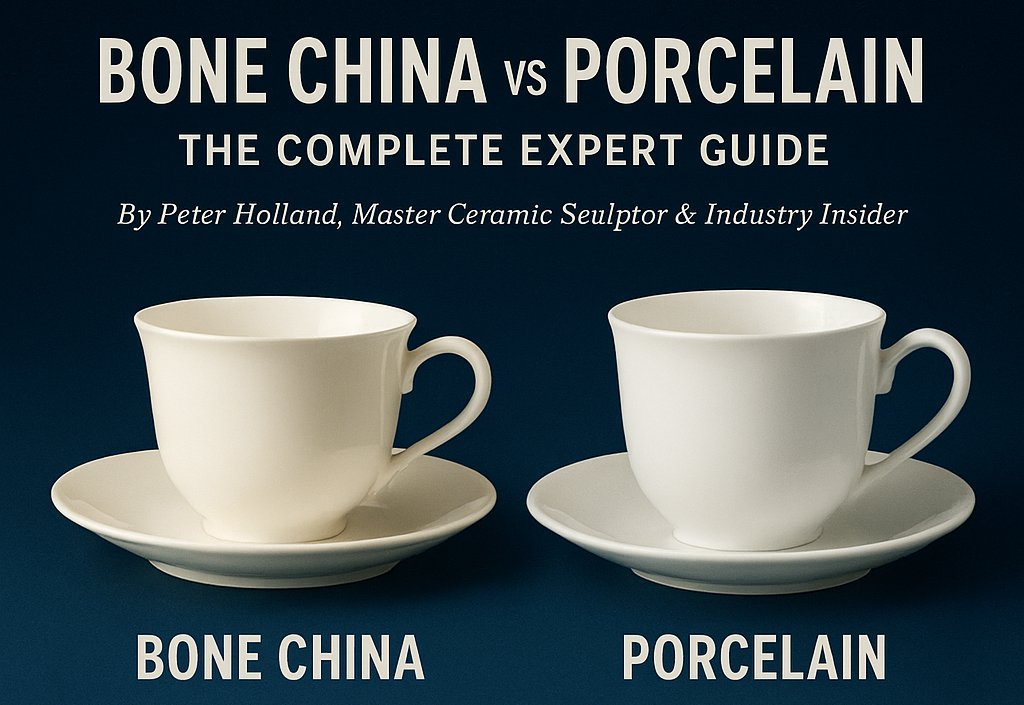 Bone china vs porcelain
Bone china vs porcelainPorcelain uses pure mineral ingredients and is fired at a higher temperature than bone china, with porcelain typically reaching around 1400°C (2550°F). Bone china has an organic addition of bone ash, and is fired between 1200°C and 1250°C (2190°F and 2280°F). This difference in firing temperature, along with the addition of bone ash to bone china, results in porcelain being a denser, harder, whiter and more glass-like. Bone china is thinner, more delicate in appearance, and more translucent.
The apparent delicate appearance of bone china belies the fact that studies show (eg. the Journal of the American Ceramic Society - Mumford & Whittington, 1967), found that the bending strength of bone china is significantly higher than that of hard porcelain because bone ash introduces an apatite crystalline structure that reinforces it. It has a high mechanical strength and chip resistance in comparison to the other mineral only porcelains.
Bone china's bone ash content gives it the unique creamy colour, high translucency, and resilience - great for for elegant tableware, but is also extensively used by English makers for their figurine production.
Table of Contents
- Quick Comparison Chart
- The Fundamental Differences
- Composition & Manufacturing
- Physical Properties Compared
- Practical Applications
- Cost Analysis
- Expert Identification Guide
- Historical Context
- Professional Sculptor's Insights
- Buying Guide & Recommendations (Bone China vs Porcelain)
- Care & Maintenance
- Investment Value
- Frequently Asked Questions
- Conclusion
Quick Comparison Chart
Bone china vs porcelain
Here is a direct comparison of the two materials so you can see every distinction at a glance. This table will serve as your quick-reference guide before we dive into the details.
| Characteristic | Bone China | Porcelain |
|---|---|---|
| Key Ingredient | 30-50% calcined bone ash | Pure kaolin, feldspar, quartz |
| Firing Temperature | 1,200°C (2,192°F) | 1,300-1,450°C (2,372-2,642°F) |
| Color | Warm creamy white, ivory undertones | Cool bright white, sometimes blue-tinted |
| Translucency | Exceptional - see hand shadows clearly | Good when thin, less than bone china |
| Weight | Lighter (20-30% less than porcelain) | Denser, heavier feel |
| Strength Type | Flexible, chip-resistant | Hard but more brittle |
| Sound When Tapped | Soft, melodic bell tone | Clear, high-pitched ring |
| Thickness Capability | Ultra-thin walls possible | Requires more substantial thickness |
| Price Range | Premium ($50-500+ per place setting) | Wide range ($20-300+ per place setting) |
| Best Use | Fine dining, special occasions | Everyday use, professional kitchens |
| Origin | England, 1790s | China, Tang Dynasty (618-907 AD) |
| Dishwasher Safety | Generally safe (check decorations) | Excellent dishwasher durability |
| Microwave Safety | Safe (avoid metallic decorations) | Excellent microwave performance |
| Thermal Shock Resistance | Moderate | Excellent |
| Scratch Resistance | Good | Superior |
| Investment Potential | High for British makers | Variable by origin/maker |
The Fundamental Differences
Bone china vs porcelain
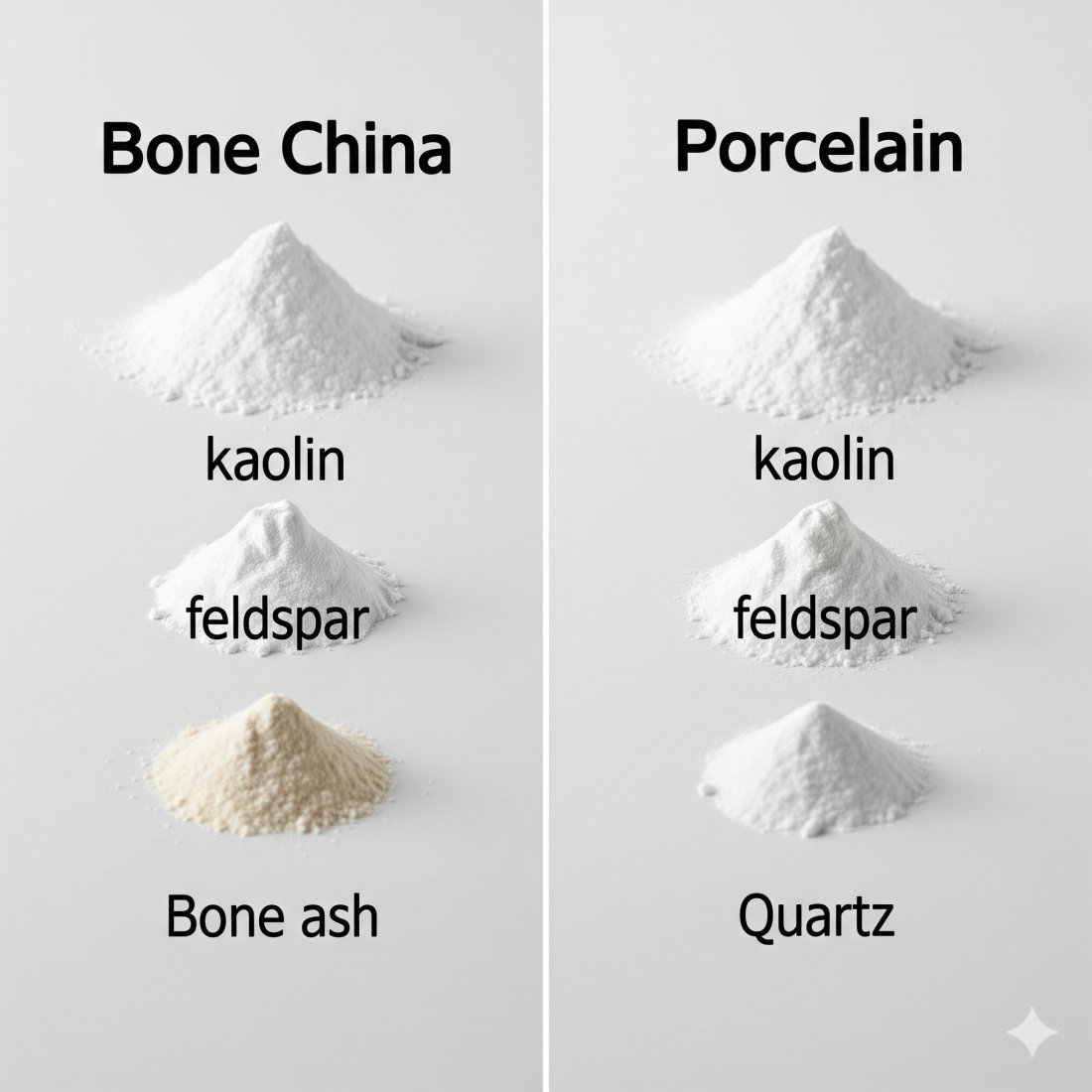
What Makes Bone China Utterly Unique?
Bone china's defining characteristic is its bone ash content, typically 30-50% of the total composition. This isn't just an additive; it's a revolutionary ingredient that transforms every aspect of the ceramic:
The Bone Ash Advantage:
- Lower firing temperature allows for thinner, more delicate forms
- Enhanced translucency creates an almost luminous quality
- Flexible strength that resists chipping better than pure ceramics
- Unique warmth in both color and tactile feel
What Makes Porcelain Superior To Most Other Ceramics?
Porcelain's strength lies in its purity and mineral perfection:
The Pure Mineral Formula:
- Kaolin clay (40-60%) provides the white base and plasticity
- Feldspar (25-35%) acts as flux for vitrification
- Silica/Quartz (15-25%) adds structural strength
- No organic additives means consistent, predictable properties
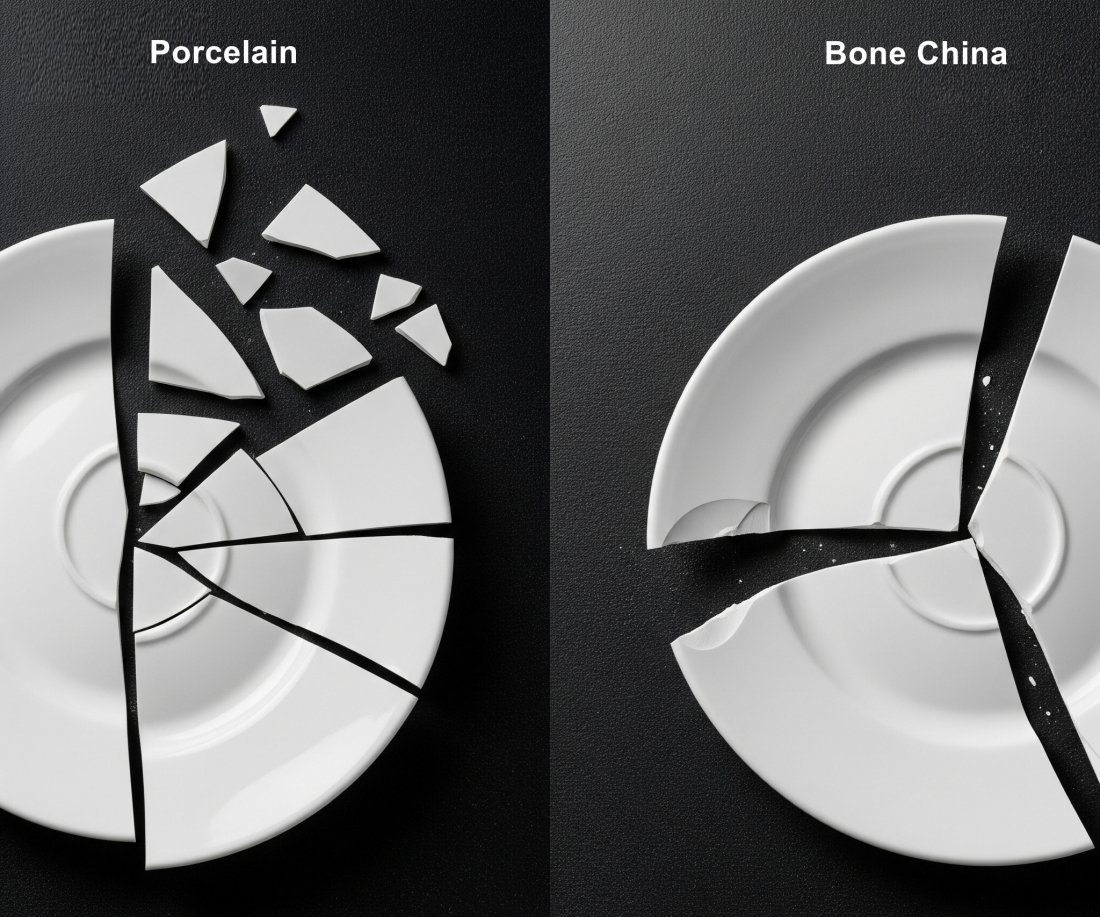 Strength test bone china vs porcelain
Strength test bone china vs porcelainComposition & Manufacturing
Bone china vs porcelain
Bone China Production Process
Step 1: Bone Preparation
- Cattle bones are cleaned and calcined at 1,000°C
- Bones are ground to fine powder (bone ash)
- Ash is mixed with kaolin and feldspar in precise ratios
Step 2: Forming and First Fire
- Pieces shaped at leather-hard stage
- First firing (bisque) at 1,200-1,250°C
- Lower temperature preserves delicate details
Step 3: Glazing and Final Fire
- Clear glaze applied for protection and shine
- Final firing at 1,050-1,100°C
- Results in characteristic warm translucency
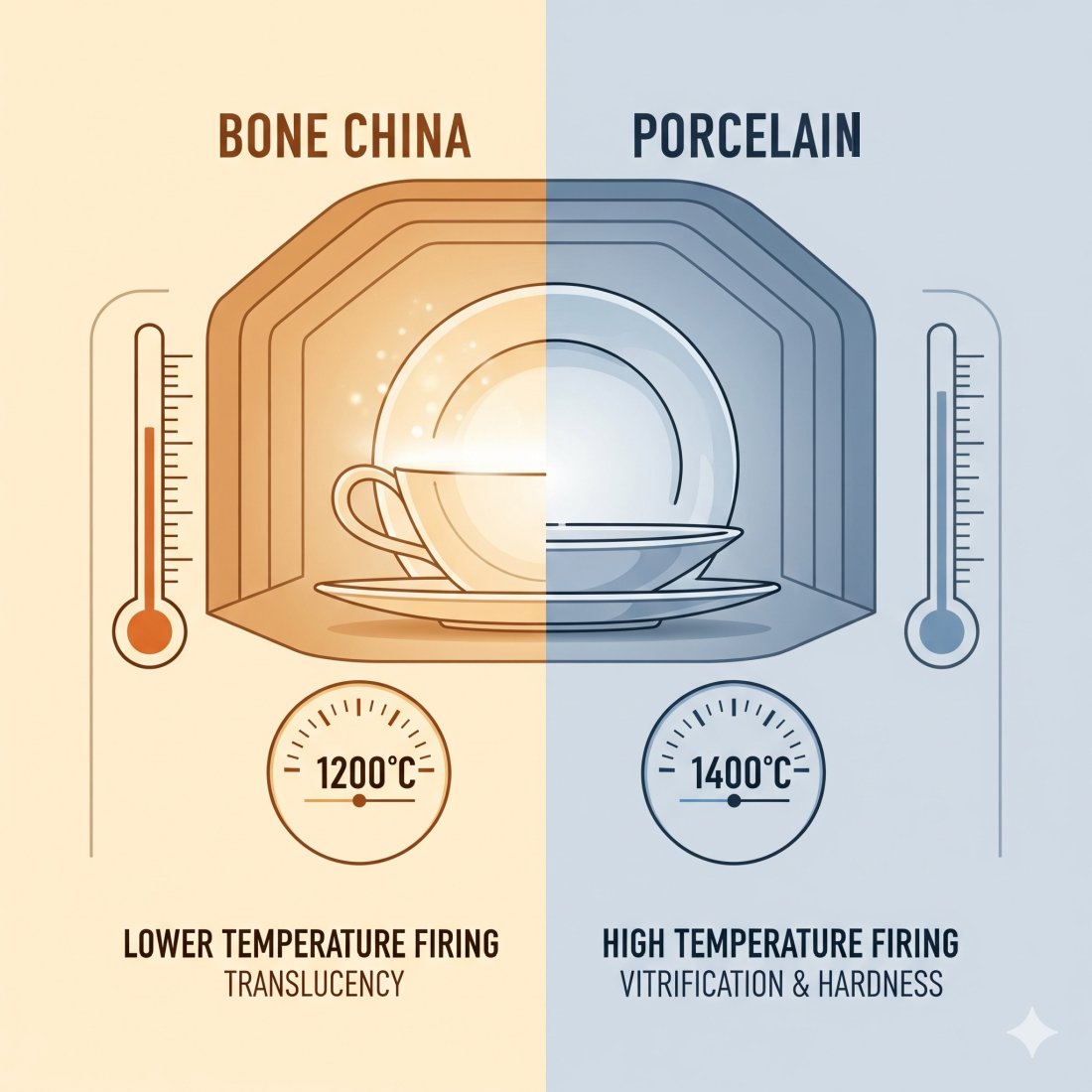
Porcelain Production Process
Bone china vs porcelain
Step 1: Material Preparation
- Pure kaolin clay refined and aged
- Feldspar and silica ground to specific mesh sizes
- Materials mixed in precise proportions (no organic matter)
Step 2: High-Temperature Firing
- Pieces fired at 1,300-1,450°C
- Extreme heat vitrifies the body completely
- Creates glass-like, non-porous structure
Step 3: Optional Glazing
- Can be left unglazed for artistic applications
- Glazed pieces require additional firing
- Results in brilliant white, highly durable finish
Physical Properties Compared
Translucency Test Results
Bone China: Hold a 2mm thick piece to bright light, you can clearly see finger shadows and even read large text through it.
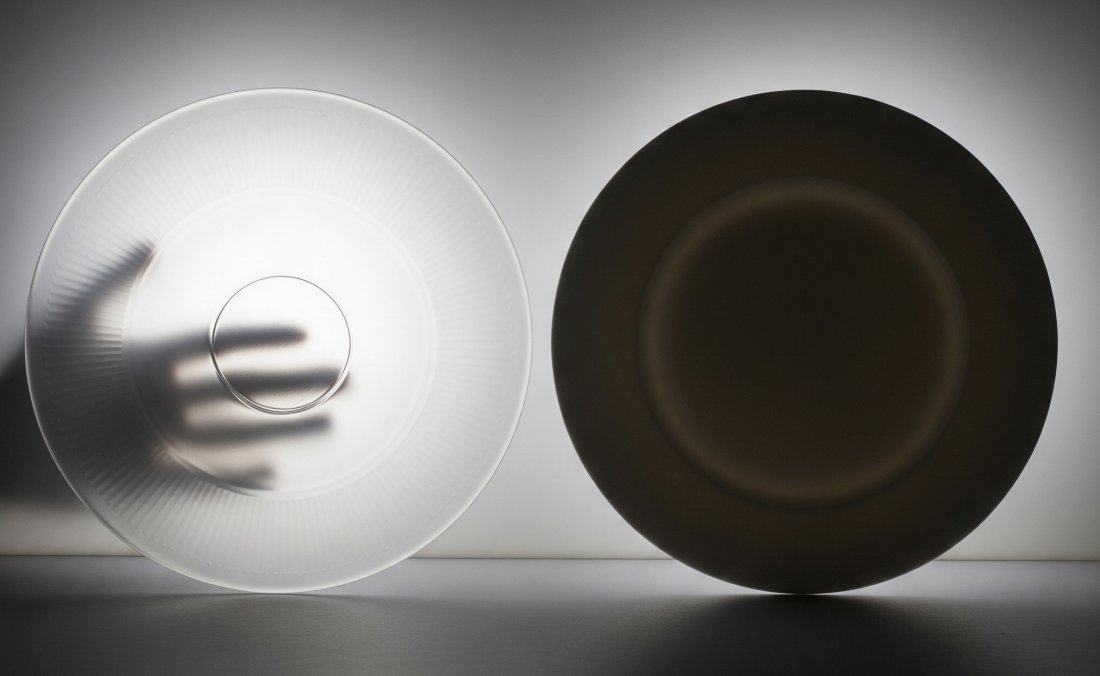 Look for your shadow through the plate. Bone china is more translucent than porcelain, but less so than glass
Look for your shadow through the plate. Bone china is more translucent than porcelain, but less so than glassPorcelain: Similar thickness shows moderate translucency but with less clarity than bone china. Thicker porcelain (3mm+) appears nearly opaque.
Weight Comparison
Bone China Dinner Plate (10.5"): Typically 280-320 grams
Porcelain Dinner Plate (10.5"): Typically 380-450 grams
The 20-30% weight difference is immediately noticeable when handling.
Strength Testing
Impact Resistance:
- Bone China: Flexible strength absorbs minor impacts; chips tend to be small
- Porcelain: Superior scratch resistance but more catastrophic failure when dropped
Thermal Shock:
- Bone China: Moderate resistance; avoid extreme temperature changes
- Porcelain: Excellent performance; can handle rapid temperature changes
For a more in-depth look at the science behind bone china vs porcelain, a study from 2007 covers this in depth: "A comparative study between bone china and hard porcelain", which analyses their technical properties, composition, and mechanical strength using scientific methods
Practical Applications
Where Bone China Excels
Fine Dining Applications:
- Wedding china - Elegant appearance for special occasions
- Hotel luxury dining - Impresses guests while resisting service wear
- Collector figurines - Superior detail preservation in thin sections
- Tea services - Traditional British elegance with practical durability
Professional Recommendations:
- Choose for entertaining guests
- Ideal for foods requiring presentation
- Perfect for candlelit dining (translucency glows beautifully)

Where Porcelain Dominates
Everyday Use Applications:
- Family dinnerware - Withstands daily handling and cleaning
- Commercial kitchens - Resists professional dishwasher cycles
- Bakeware - Excellent thermal properties for oven use
- Artistic applications - Unglazed porcelain preserves finest sculptural details
Professional Recommendations:
- Choose for durability-first applications
- Ideal for high-temperature cooking vessel linings
- Best for pieces requiring maximum scratch resistance
Cost Analysis
Initial Investment
Bone China:
- Entry Level: £40-80 per place setting (basic patterns)
- Mid-Range: £80-200 per place setting (established brands)
- Luxury: £200-500+ per place setting (Royal Crown Derby, Spode)
Porcelain:
- Entry Level: £15-40 per place setting (everyday use)
- Mid-Range: £40-120 per place setting (quality brands)
- Luxury: £120-300+ per place setting (Meissen, Royal Copenhagen)
Long-Term Value
Replacement Costs: Bone china patterns often discontinue faster, making replacement pieces expensive. Porcelain patterns tend to have longer production runs.
Durability Economics: While porcelain costs less initially, bone china's chip resistance can mean fewer replacements over time for careful users.
Expert Identification Guide
Bone china vs porcelain
Visual Identification
Color Temperature Test:
- Bone China: Place white paper next to the piece, bone china appears warm/creamy
- Porcelain: Shows cool white, sometimes with blue undertones
Physical Tests
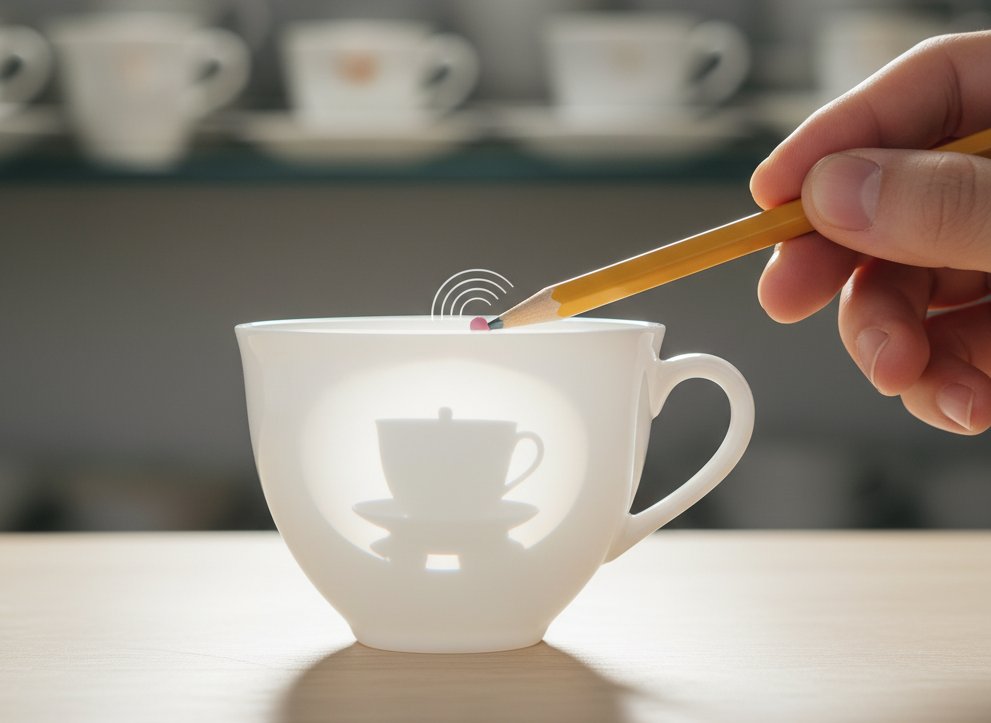 Listen for the distinct sound when tapped
Listen for the distinct sound when tappedThe Ring Test:
- Suspend piece by rim or handle
- Tap gently with pencil eraser
- Bone China: Soft, melodic bell sound (lower pitch)
- Porcelain: Clear, sharp ring (higher pitch, longer sustain)
The Weight Test:
Similar-sized pieces will have noticeable weight difference, porcelain feels substantially heavier.
The Light Test:
Hold piece to bright light source:
- Bone China: Exceptional translucency with clear shadow definition
- Porcelain: Good translucency but less dramatic than bone china
Microscopic Differences
Under 10x magnification:
- Bone China: Slightly more open structure visible
- Porcelain: Denser, more vitrified appearance
Historical Context
Bone china vs porcelain
The Chinese Porcelain Monopoly (618-1708 AD)
For nearly 700 years, China held the world's only true porcelain formula as a closely guarded state secret. European attempts to replicate it led to:
- Imprisonment of alchemists until they "discovered" the formula
- Massive royal expenditures on failed experiments
- Development of inferior soft-paste substitutes
The European Breakthrough (1708)
German alchemist Johann Friedrich Böttger finally cracked the code, leading to:
- Europe's first porcelain factory at Meissen
- Spread of hard-paste porcelain across continental Europe
- End of Chinese monopoly on true porcelain
The British Innovation (1790s)
 Josiah Spode finally develops bone china c.1796 as an attempt at creating the secretive porcelain recipe. The rest is history.
Josiah Spode finally develops bone china c.1796 as an attempt at creating the secretive porcelain recipe. The rest is history.Unable to compete directly with continental porcelain, British potters developed bone china:
- Josiah Spode perfected the formula around 1794
- Added calcined bone ash to create unique properties
- Created a distinctly British ceramic tradition
The Great Ceramic Rivalry
This led to a fascinating cultural divide:
- Continental Europe: Focused on hard-paste porcelain perfection
- Britain: Developed bone china as national specialty
Result: Two distinct ceramic traditions that persist today
 Now you know which is which and why
Now you know which is which and whyProfessional Sculptor's Insights
Working with Both Materials
Having sculpted for Royal Worcester, Coalport, and Royal Doulton, I've experienced how these materials behave when cast, fired and decorated.:
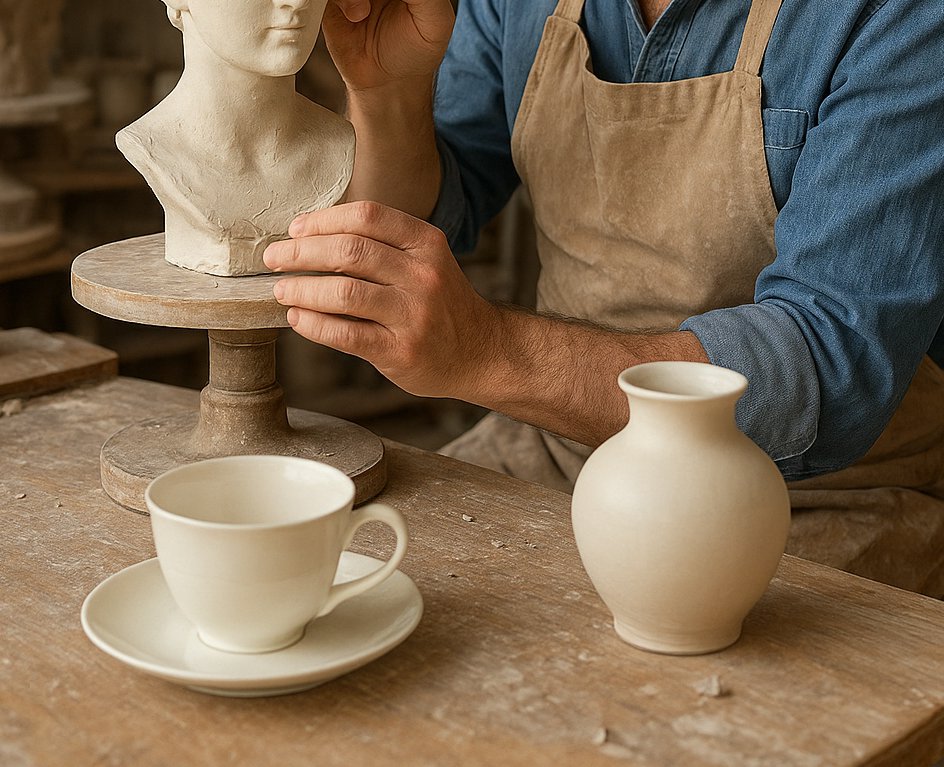 Whether cast in porcelain or bone china, it all starts with the modelling/sculpting process
Whether cast in porcelain or bone china, it all starts with the modelling/sculpting processBone China Advantages in Production:
- Consistent firing - Predictable results from kiln
- Thin wall capability - Allows for delicate, detailed work
- Fine detail retention - Preserves subtle facial expressions, even after glazing
Porcelain Advantages in Sculpture:
- Absolute fidelity - Every tool mark preserved perfectly
- Unglazed beauty - Can remain unglazed for pure ceramic expression
- Permanence - Bone china more susceptible to temperature changes (may crack)
- Keeps tool detailing - Crisp edges and sharp details possible (especially if unglazed)
The Glazing Decision
Why I Often Left Porcelain Unglazed:
Glazing fills microscopic details, softening the sharp precision of sculptural work. For Coalport's porcelain collections, we deliberately left pieces unglazed (bisque fired only) to preserve every nuance of the original modeling.
When Bone China Required Glazing:
Bone china's slightly more porous nature meant glazing was usually necessary for durability, but the glaze could be kept very thin to preserve detail. This creates the luxury jewel like gloss that collectors find irresistible
The Collector's Tribal Choice
In late 20th-century Britain, choosing bone china vs porcelain was as passionate as choosing Beatles vs Rolling Stones:
The Bone China Tribe:
- Valued English heritage and tradition
- Appreciated warmth and translucency
- Focused on domestic manufacturers (Royal Doulton, Royal Worcester, Coalport, Royal Albert, Spode etc.)
The Porcelain Purists:
- Sought crystalline perfection and international excellence
- Collected continental European pieces (Meissen, Royal Copenhagen) as well as the Coalport porcelain ranges.
- Valued artistic and historical significance
Both groups were absolutely right, they were simply aligned to different aesthetic philosophies.
Buying Guide & Recommendations (Bone China vs Porcelain)
Best Bone China Brands
Heritage British Makers:
- Spode: Original bone china innovators, excellent quality
- Royal Albert: Known for floral patterns and thin, elegant forms
- Wedgwood: Premium quality with modern and traditional designs
- Royal Crown Derby: Ultimate luxury, hand-painted excellence
- Royal Doulton: Brought to prominence by C.J. Noke early 20th century
- Royal Worcester: Considered the oldest porcelain factory in England.
Modern Considerations:
- Many traditional makers now manufacture overseas
- Check country of origin if British heritage matters to you
- Quality remains high regardless of manufacturing location
- Fine Bone China makers in Stoke-on-Trent: Still producing quality pieces
Best Porcelain Brands
European Excellence:
- Meissen: German pioneers, still producing exceptional pieces
- Royal Copenhagen: Danish quality with distinctive blue patterns
- Villeroy & Boch: German engineering meets elegant design
- Limoges (various makers): French porcelain excellence
- Nymphenburg (Germany): Renowned for its masterpieces of Rococo art since 1747.
- Doccia/Ginori (Italy): While famous for its Florentine artistry, Doccia also produced a wide array of other items.
- Imperial Porcelain Factory (Russia): Particularly recognized for its exquisite works and famous cobalt net pattern.
Asian Quality Leaders:
- Noritake: Japanese precision and reliability.
- Arita (Japan): Includes a wide range of plates, bowls, cups, and serving pieces with modern design.
- Kutani (Japan): Known for vibrant overglaze decoration.
- Imari (Japan): Though technically a style of Arita ware, Imari-branded tableware is still produced and sold.
- Kakiemon (Japan): Produces refined tableware using traditional techniques, often in limited runs.
- Fukagawa (Japan) (Koransha): Offers elegant tableware with imperial associations—think cobalt blues, cranes, and cherry blossoms.
- Okura (Japan): Boutique-level tableware, often used by the Imperial Household. Refined, understated, and high quality.
What to Look For When Buying
Quality Indicators:
- Even thickness throughout the piece
- Smooth, bubble-free glaze (if glazed)
- Clean, sharp rim edges without chips
- Consistent color across the entire piece
- Proper ring when tapped (indicates good firing)
Red Flags:
- Uneven thickness (indicates poor craftsmanship)
- Glaze bubbles or pits (firing problems)
- Color variations within single piece (material issues)
- Dull sound when tapped (underfired or cracked)
Care & Maintenance
Daily Care Best Practices
Bone China:
- Hand washing preferred - Use warm water and mild detergent
- Avoid thermal shock - Don't pour boiling water into cold china
- Stack carefully - Use protective pads between pieces
- Store properly - Vertical storage for plates when possible
Porcelain:
- Dishwasher safe - Most modern porcelain handles machine washing
- Temperature versatile - Can handle rapid temperature changes better
- Stack securely - Heavier weight requires secure stacking
- Clean easily - Non-porous surface resists staining
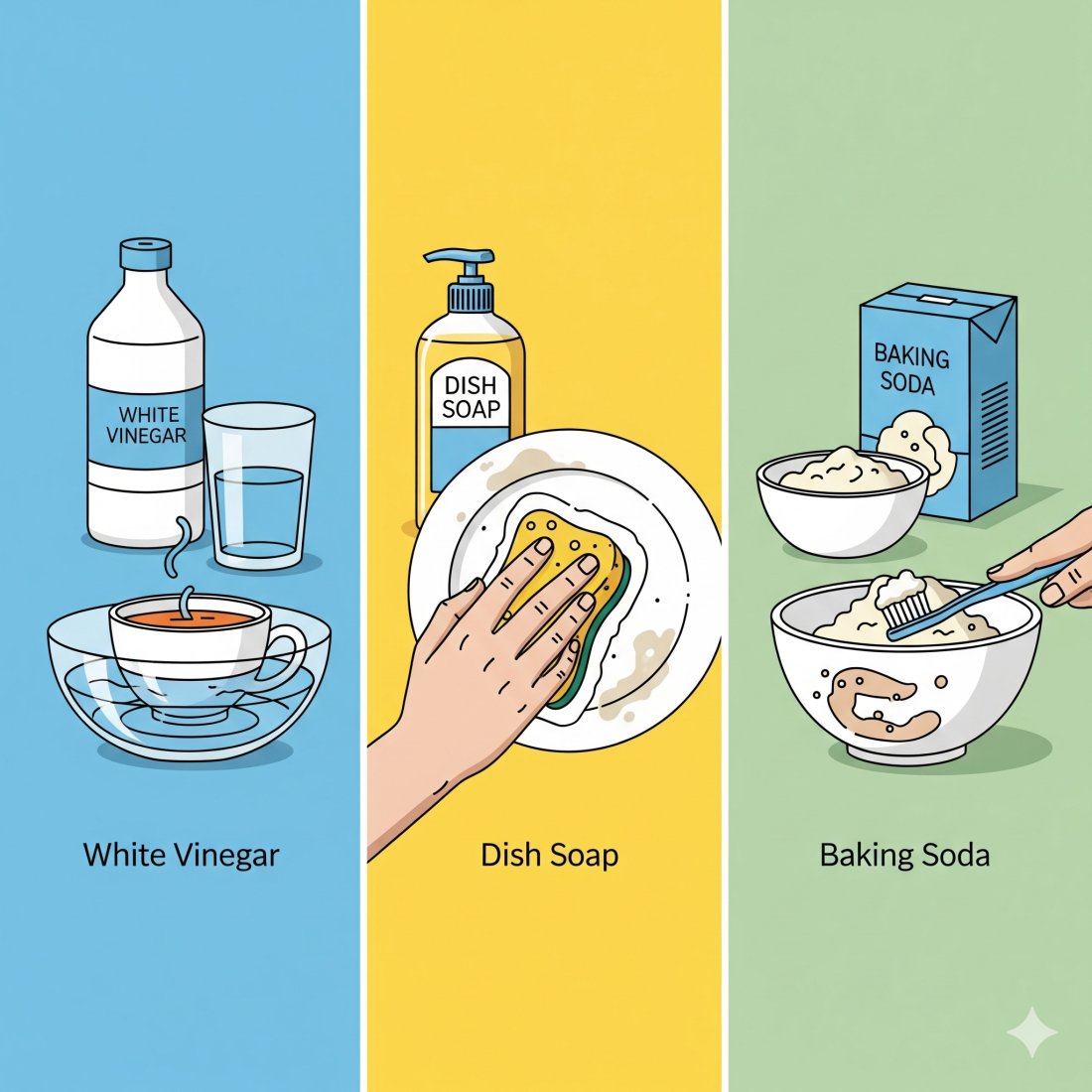
Professional Cleaning Tips
Removing Stains:
- Tea/Coffee stains: Soak in solution of 1 part white vinegar, 2 parts water
- Grease marks: Dawn dish soap with warm water
- Stubborn stains: Baking soda paste, let sit 30 minutes before scrubbing gently
Avoiding Damage:
- Never use abrasive cleaners on either material
- Avoid sudden temperature changes especially for bone china
- Check decoration durability before dishwasher use
- Hand dry immediately to prevent water spots
Long-Term Preservation
Storage Solutions:
- Felt-lined cabinets protect from scratches
- Vertical plate storage reduces stacking pressure
- Climate control prevents thermal stress
- Regular use actually helps prevent degradation
Professional Restoration:
- Both materials can be professionally restored, but:
- Bone china repairs are more complex due to bone ash content
- Porcelain restoration often achieves better color matching
- Cost vs value analysis important for restoration decisions
Investment Value
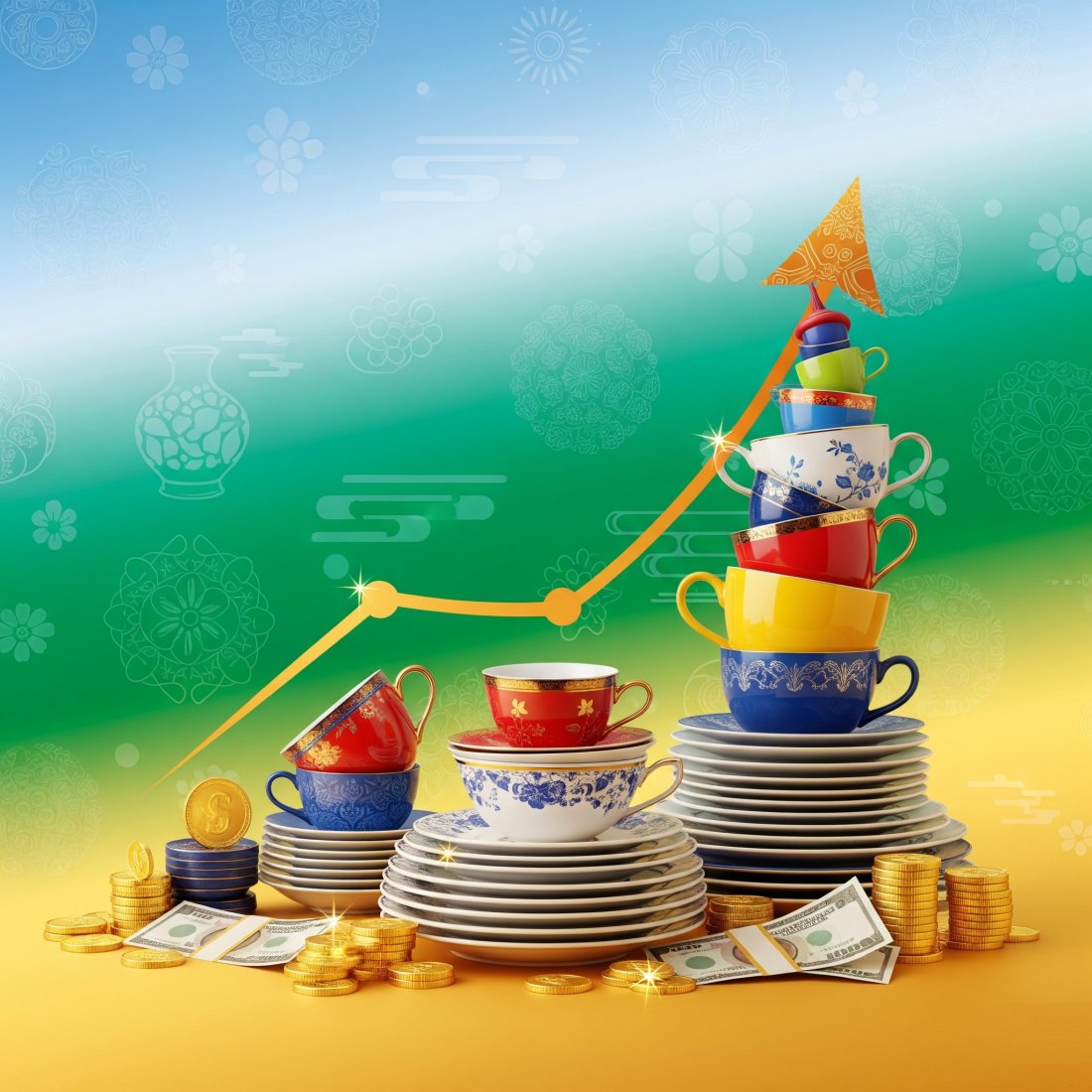
Market Trends (2024-2025)
Bone China Appreciation:
- Vintage British pieces (1900-1970) showing strong growth
- Limited editions particularly valuable
- Complete sets command premium prices
- Condition critical - chips dramatically reduce value
Porcelain Investment Patterns:
- 18th-19th century European pieces remain blue-chip investments
- Contemporary art pieces showing increasing interest
- Asian porcelain recovering strongly post-2020
- Maker reputation drives significant value differences
Factors Affecting Value
Positive Value Drivers:
- Maker reputation and historical significance
- Age and rarity of specific patterns
- Condition (chips, cracks, restoration history)
- Completeness of sets
- Provenance and documentation
- Current collecting trends
Value Detractors:
- Chips or cracks (even hairline cracks matter)
- Restoration (professional restoration can help but affects value)
- Common patterns mass-produced pieces
- Missing pieces from sets
- Poor storage damage (crazing, discoloration)
Investment Recommendations
For New Collectors:
- Start with condition - better to have fewer perfect pieces
- Focus on makers you personally enjoy
- Buy complete sets when possible
- Document everything (photos, purchase records, history)
For Serious Investors:
- Research market trends before major purchases
- Condition is king - never compromise on condition
- Diversify across time periods and makers
- Professional appraisal for valuable pieces
Frequently Asked Questions
Can you put bone china in the dishwasher?
Most modern bone china is dishwasher-safe, but check for metallic decorations which can be damaged. Use gentle cycles and avoid overcrowding to prevent chips.
Which is more expensive, bone china or porcelain?
Bone china typically costs more due to the complex manufacturing process and premium positioning. However, high-end porcelain can exceed bone china prices depending on maker and rarity.
Is bone china vegan?
Traditional bone china contains calcined animal bone ash (typically from cattle). Some manufacturers now produce "vegan bone china" using plant-based alternatives, but these have different properties.
Why does bone china feel different from porcelain?
The bone ash content makes bone china lighter and gives it a warmer, more organic feel compared to porcelain's cooler, denser mineral composition.
Can you repair chipped bone china?
Yes, both bone china and porcelain can be professionally repaired. However, bone china repairs are more complex due to the bone ash content affecting color matching and adhesion.
Which lasts longer, bone china or porcelain?
Both can last centuries with proper care. Porcelain has slight advantage in scratch resistance, while bone china excels in chip resistance during normal handling.
Is all bone china from England?
No, bone china is now manufactured worldwide. However, the technique originated in England, and British makers like Spode maintain strong reputations for quality.
Conclusion: Making Your Choice

After decades of working with both materials, I can confidently say there's no universal "winner" between bone china and porcelain. The choice depends entirely on your specific needs, aesthetic preferences, and intended use.
Choose Bone China If:
- You prioritize elegance and special occasion dining
- Lightweight, translucent beauty appeals to you
- You appreciate British ceramic heritage
- Chip resistance during careful handling is important
- You value the warm, creamy aesthetic
Choose Porcelain If:
- Durability and everyday practicality matter most
- You prefer cool, bright white aesthetics
- If you want to pay less than bone china equivalent
- You need pieces for professional kitchen use
- Historical ceramic traditions appeal to you
The Professional Perspective:
Both bone china and porcelain represent pinnacles of ceramic achievement. Bone china showcases British innovation and engineering, creating properties impossible through mineral ingredients alone. Porcelain demonstrates the perfection possible through pure materials and high-temperature firing.
Understanding these differences makes you not just a more informed buyer, but a "clay insider" who truly appreciates what goes into creating these remarkable materials.
Ready to explore the complete world of fine ceramics? Discover more in our comprehensive guides:
About the Author: Peter Holland is a renowned ceramic sculptor whose work graced collections at Royal Worcester, Coalport, and Royal Doulton. With over three decades of hands-on experience with both bone china and porcelain, he brings unparalleled professional insights to ceramic appreciation and collecting.
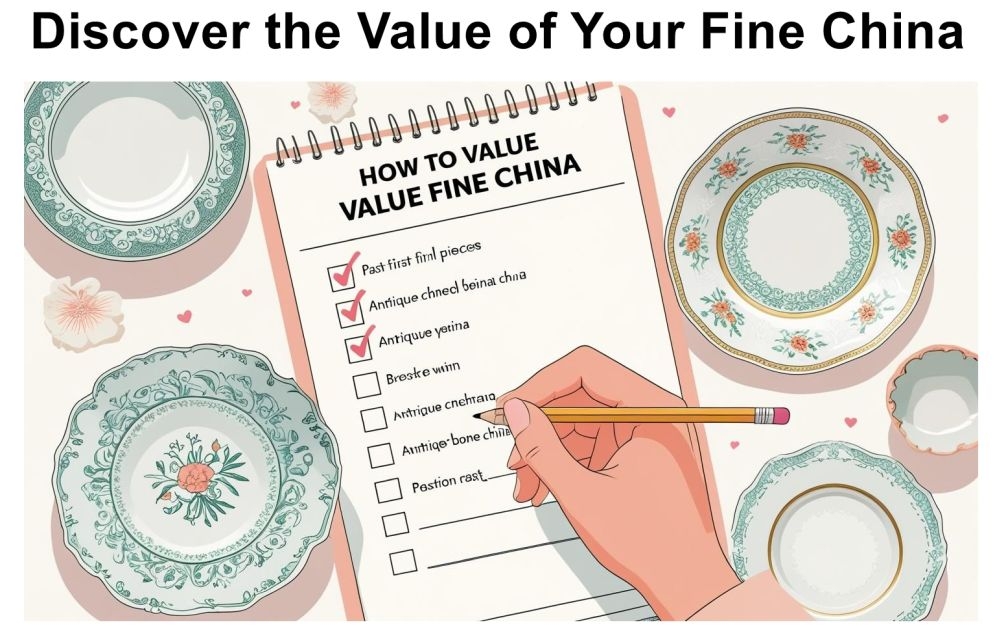
Inherited a china set?... Download my free 7-point checklist to instantly assess its potential value.
From the Studio
• Peter Holland Posters
• Sculpture Studio







